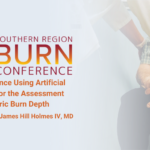Abstract | December 20, 2021
Initial Experience Using Artificial Intelligence for the Assessment of Pediatric Burn Depth
Learning Objectives
- Learn about treatment decisions that are influenced by the assessment of a pediatric burn injury.
- Learn about the importance of accurate data in the development of a diagnostic imaging device.
- Learn how a multispectral imaging can be used to identify burn depth/severity in the clinical setting.
Introduction:
The estimation of burn depth, and hence severity, is critical for managing the care of burn patients. These burn depth estimates vary widely, with burn surgeons reporting up to 70-80% accuracy and non-burn specialists a 50-60% accuracy. Owing to multiple factors, these inaccuracies can be further compounded in pediatric burns. A reliable, objective, non-invasive device for the accurate assessment of burn depth is needed. A non-invasive imaging technology, multispectral imaging (MSI), combined with a machine learning algorithm is being developed as a rapid tool for accurate burn depth assessment. The results of the first multi-center study using this artificial intelligence (AI) technology in pediatric burns are presented.
Methods:
In this multi-center IRB-approved study, an MSI device was used to image subjects younger than 18 years of age with thermal burns up to 50% TBSA. The imaging device captured a set of images measuring the reflectance of visible and near-IR light within a 23 cm by 23 cm field-of-view. Images were collected from up to 2 separate burned regions on subjects. Subjects were enrolled and imaged within 72 hours of injury and then serially imaged for up to 7 days post-injury. Burns that the investigator believed would heal spontaneously (superficial/1st degree or superficial partial-thickness/2nd degree) were managed per institutional standards of care (SOC) and assessed at 21 days post-injury for complete healing. Burns that the investigator felt would not heal by 21 days post-injury (deep partial-thickness/2nd degree or full-thickness/3rd degree) were excised and grafted per institutional SOC, with multiple biopsies being taken for histological analysis prior to excision. The images were collated for review, and the actual regions of non-healing burn within every MSI image were identified by a panel of 3 burn surgeons. To accurately identify these non-healing regions, the panel of surgeons were given access to 1 of 2 clinical reference standards: a) the 21-day healing assessments for burns allowed to heal spontaneously; or b) pathology reports detailing histologic analyses from the multiple punch biopsies taken prior to excision and grafting. This information was then used to develop a type of machine learning algorithm called a convolutional neural network (CNN) that could automatically identify the regions of non-healing burn within an image. From these data, an ensemble of 8 separate CNN algorithms was used to automatically identify non-healing burn tissue. During algorithm development, the ensemble comprised a set of CNNs that were variations on the U-Net, fully connected CNN, and SegNet architectures. Training and test accuracies of the ensemble CNN were calculated using cross-validation at the level of the subject.
Results:
Twenty-four (24) pediatric burn patients were enrolled, with 26 burned areas being serially imaged. The age range of the subjects was 7 months to 17 years, with a mean age of 5.7 years. Subjects had a mean burn size of 8.0 ± 4.2% TBSA, and 70% of the subjects were male. The AI performance results showed an accuracy of 88.2 ± 3.7%, sensitivity of 80.0 ± 14.6%, specificity of 88.0% ± 3.7%, and an area under the curve (AUC) of 0.92.
Conclusions:
Our study demonstrates a dramatic improvement in the accuracy of burn depth assessment over the traditional bedside exam. More accurate burn depth assessment could potentially lead to avoiding unnecessary operations or delays in treatment/referral, reduced inpatient lengths of stay, more rapid return to normal activities and school for children, and overall treatment cost savings. Use of such a device in a disaster has additional value to better align limited resources with actual clinical needs. Technologies such as this offer great potential in burn care and will require strategic incorporation into practice once commercially available.

